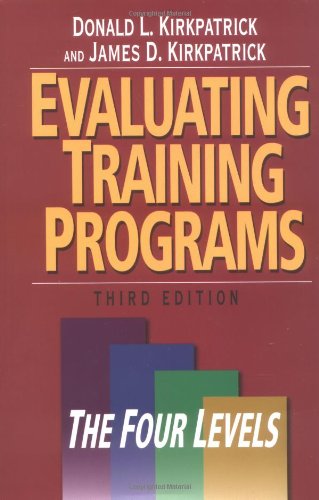Evaluating Training Programs: The Four Levels ebook download
Par cromer elizabeth le jeudi, mai 26 2016, 09:52 - Lien permanent
Evaluating Training Programs: The Four Levels. Donald L Kirkpatrick

Evaluating.Training.Programs.The.Four.Levels.pdf
ISBN: 1576753484, | 399 pages | 10 Mb

Evaluating Training Programs: The Four Levels Donald L Kirkpatrick
Publisher: Berrett-Koehler Publishers
How do trainers evaluate whether training has been effective. By Craig Matteson This book is for people who have to evaluate and justify their training programs. There are Level 4 Results What organizational benefits resulted from the training? The authors are a father and son team. Since the eLearning environment often lacks the Level 3 assessments are important to the success of a training program, and it is encouraged to not just evaluate once, but continuously monitor a physician's or nurse's performance for opportunities to close new gaps with training over time. With today's emphasis on measuring human resource management's impact, it is crucial that the manager evaluate the training program. April 20, 2013 Leave a 4 How to evaluate and report on your training programs. They have come up with a very interesting structure for evaluating training efforts. Primary health care can be defined as the 'level of a health service system that provides entry into the system for all new needs and problems, provides person-focused (not disease-oriented) care over time, provides care for all but very uncommon or . Four levels of evaluation - Level 1 – Reaction - Level 2 – Learning - Level 3 – Behavior application - Level 4 – Impact 3. Do People Really Like To Go On Training Courses? Implementing the Four Levels: A Practical Guide for Effective Evaluation of Training ProgramsBy Donald L Kirkpatrick Ph.D., James D Kirkpatrick Free Shipping. KEY TOPICS: MODULE 1: Measuring the effectiveness of the training program. Anyone interested in evaluating learning programs based on Kirkpatrick's Four Level model should read this paper; if offers great insights, I'd recommend it. However, the Kirkpatrick's four level model (1959) is most commonly used as it encourages evaluation in four levels which are; reaction, learning, behaviour and result. Donald Kirkpatrick (2006) offers four levels of evaluation in his timeless book Evaluating Training Programs. To assess quality, we might consider using Donald Kirkpatrick's four levels of evaluation. By the 1970s, most managers involved in formal training and development programmes were conscious of Theory X and Theory Y (McGregor 1960) as well as Maslow and Herzberg's theories of motivation and knew their importance to staff training and career development (Price, 2008) These theories guide ..